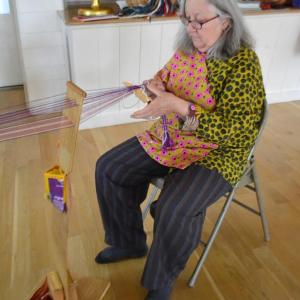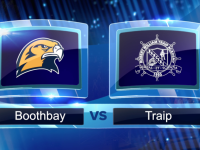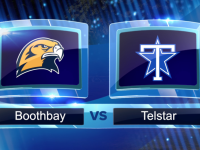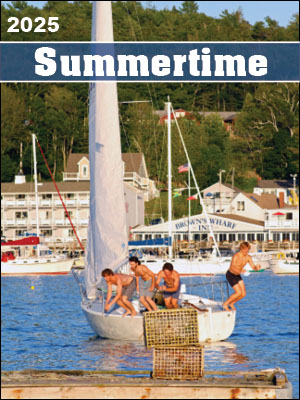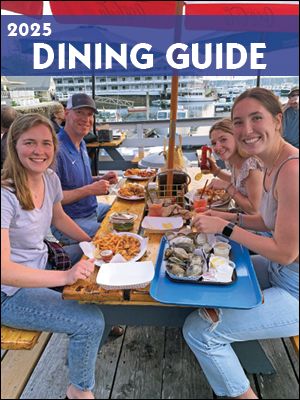Historical craftsmanship lives at BRV
 Weaver Susan Perrine showcases her craft during an exhibition at Boothbay Railway Village Museum. ISABELLE CURTIS/Boothbay Register
Weaver Susan Perrine showcases her craft during an exhibition at Boothbay Railway Village Museum. ISABELLE CURTIS/Boothbay Register
 ISABELLE CURTIS/Boothbay Register
ISABELLE CURTIS/Boothbay Register
 A handwoven cloth created by Perrine. The 30 square foot piece took her 40 hours. ISABELLE CURTIS/Boothbay Register
A handwoven cloth created by Perrine. The 30 square foot piece took her 40 hours. ISABELLE CURTIS/Boothbay Register
 ISABELLE CURTIS/Boothbay Register
ISABELLE CURTIS/Boothbay Register
 ISABELLE CURTIS/Boothbay Register
ISABELLE CURTIS/Boothbay Register
 ISABELLE CURTIS/Boothbay Register
ISABELLE CURTIS/Boothbay Register
 Weaver Susan Perrine showcases her craft during an exhibition at Boothbay Railway Village Museum. ISABELLE CURTIS/Boothbay Register
Weaver Susan Perrine showcases her craft during an exhibition at Boothbay Railway Village Museum. ISABELLE CURTIS/Boothbay Register
 ISABELLE CURTIS/Boothbay Register
ISABELLE CURTIS/Boothbay Register
 A handwoven cloth created by Perrine. The 30 square foot piece took her 40 hours. ISABELLE CURTIS/Boothbay Register
A handwoven cloth created by Perrine. The 30 square foot piece took her 40 hours. ISABELLE CURTIS/Boothbay Register
 ISABELLE CURTIS/Boothbay Register
ISABELLE CURTIS/Boothbay Register
 ISABELLE CURTIS/Boothbay Register
ISABELLE CURTIS/Boothbay Register
 ISABELLE CURTIS/Boothbay Register
ISABELLE CURTIS/Boothbay Register
Visiting Boothbay Railway Village Museum (BRV), guests are transported into the past through the museum's collection of historical buildings and antique transportation, but the museum's newest Craft Heritage program is deepening the emersion with exhibits from local sculptors, weavers and blacksmiths.
The goal is to highlight Maine artisans while showcasing the historical crafts practiced during the museum’s time period, explained BRV marketing and events coordinator Lori Reynolds. “It's just another way to show that we are a living history museum.”
One artist is Woolwich-based weaver Susan Perrine, who, along with her husband, helped restore one of the looms BRV has on display. During her Sept. 11 demonstration, she showcased a 30 square foot cloth she recently wove to make a jacket. It took her about 40 hours.
“People don't think about textiles. They just exist, and you don't think about how they're made,” said Perrine.
However, it wasn’t that long ago that people cared deeply about who, and what, was weaving their cloth. According to Perrine, clothes-making was a cottage industry until the Industrial Revolution of the 1800s, which took weaving out of the home and into the factories, often automating it along the way; riots broke out over the shift.
Perrine became involved in weaving as an 18-year-old in the ‘70s while apprenticing with artist Carol Schwartzott, in her home state of New York. Perrine would eventually move to Rhode Island and work in a mill on 30 to 40-foot-long, mid-19th-century weaving machines to create inch-wide tapes.
This was when Perrine got experience on the “Jacquard” loom. According to Perrine and a video the Henry Ford museum did (How an 1803 Jacquard Loom Led to Computer Technology), the Jacquard loom, invented in 1801, is equipped with “punch cards” that are read by a series of pins to make weaving intricate patterns easier and more consistent. This punch card style of information reading is also what was used by early computers, making the loom a distant forefather of the internet age.
Textiles and technological advancement often go hand-in-hand, Perrine explained. For example, NASA owes the success of modern space exploration to textiles in more than one way. The Apollo spacesuits were the brainchild of the bra manufacturer, Playtex, who were able to create a layered design (some layers were composed of bra and girdle material) that had the flexibility astronauts needed. At the same time, female workers were weaving metal wires through rings to create “core memory” for the Apollo Guidance Computer.
“We wouldn't be surviving without textiles. We wouldn't be in space without textiles.”
Perrine’s work can be purchased at her demonstrations. Pieces are also on display at Markings Gallery in Bath. Artisan exhibitions will be at the museum on Sept. 23, 25 and 30, and Oct. 1, 7, 8 and 9. More information is on their website.

